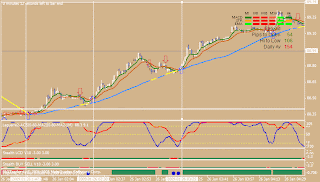Technical Analysis(TA) indicators are are mainly divided into two separate groups:
oscillators and
momentum indicators: the former try to predict a future change in trend, while the latter help assessing whether a trend that has already started will either continue or revert.
Some of the most widely used oscillators include:
-Stochastics: an oscillator that indicates whether the market is currently in an 'overbought' or 'oversold' phase. When the stochastics graph goes beyond a certain threshold, investors' reactions are usually to sell (overbought) or buy (oversold).
-Parabolic SAR: helps identifying the end of a trend in a timely fashion on a bearish or bullish market. It is plotted on the candlestick graph, and where the index crosses the candlestick graph itself, this is generally a seen as a symptom of a trend change.
-Relative Strength Index (RSI): similarly to stochastics, indicates the strength of the current trend on a scale from 0 to 100 — 0 to 50 for bearish, 50 to 100 for bullish.
Some of the most common momentum (or lagging) indicators include:
-Simple Moving Average(SMA): average value of the last n candlesticks, where n is a configurable parameter.
-Exponential Moving Averages(EMA): similar to the simple moving average, but the most recent data has a much stronger influence over the value of the index, which means this indicator is much more sensitive to changes in value.
My second TA indicator in my daily analysis of forex is a momentum indicator: moving average.
Moving averages (MA) are the oldest and simplest indicators in trading. In times when there were no computers the easiest way to visualize the price movement was to plot them on chart. Computers turned moving averages into a powerful tool for technical analysis that is used in many different trading systems.
There are many types of it but the most widely known ones are Simple Moving Average (SMA), Exponential (EMA) and Weighted (WMA).
The main rule of trading with moving average is to look for the price to cross it. If price crosses below the moving average then it is the signal to sell the currency pair. If price crosses above the moving average then it's the signal to buy the pair. The period of averaging plays a significant role in generating trading signals. If period is small it will give high number of signals most of them will be false. But if the number of period is too high then such moving average will be too lagging and giving the signals too late.
In the market when trend changes frequently going through consolidation phases trading system based on one moving average may not give very satisfactory results. It is necessary to employ some sort of filters. But moving average itself is a good filter.
The trick is to use two different periods of averaging. The shorter period curve will change quicker with the price while the longer period curve will be slower and filtering out the false crosses of the price.
What are the best Time periods?
This of course is all down to personal preference and to a degree how volatile the market is you are trading. My own view based around my experience trading in stock and future market and reading though available information in the net , for a short term trading I prefer to use 6 and 12 period EMA, 20 period SMA,50 period SMA, 60 period EMA and 200 period EMA.
The main principal of my TA in utilizing moving average, is the crossover of 6 and 12 EMA. The trading system will generate buy and sell signals based on these crossovers. Generally a buy signal is generated when 6 period EMA cross above 12 period EMA; and a sell signal is generated in opposite situations. Confirmation of the entry is when both 6 EMA and 12 EMA cross the trend confirmation moving average, the 50 period SMA. The 50 SMA indicated an immediate term trend direction. When prices, the 6 and 12 EMA is above 50 SMA our trade position should be in the long side and vice versa.

Refer to the chart above. The arrow indicated when the 6 EMA (magenta col0r) cross 12 EMA (green color), with the arrow downward (magenta) indicating 6 EMA cross 12 EMA from above (i.e. sell) and the blue upward arrow indicating the 6 EMA cross 12 EMA from below (buy).
The 50 SMA is colored both blue and yellow. A blue color indicated that RSI is above 50 while yellow is below 50.
As stated before that moving average is a momentum indicator, when prices consolidated the moving average crosses signals did not cleanly showed for our entry(Note: on the chart at the end of the period the prices went sideway with the crosses showing false signal). Therefore we need to know when the prices will be trending and when it will consolidate or ranging. To identify it, i utilised the Bollinger band and using the 60 and 200 EMA. The 60 and 200 EMA is also used to identified support and resistance. This subjects will be explain later.



























